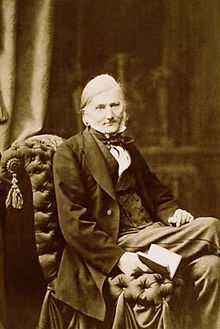Oswald Heer
| Oswald Heer | |
|---|---|
 | |
| Born |
August 31, 1809 Nieder-Utzwyl, Switzerland |
| Died |
September 27, 1883 (aged 74) Lausanne |

Oswald Heer (or Oswald von Heer) (August 31, 1809 – September 27, 1883), Swiss geologist and naturalist, was born at Niederuzwil in Canton of St. Gallen and died in Lausanne.
Biography
Oswald Heer was educated as a clergyman at Halle and took holy orders, and he also graduated as Doctor of Philosophy and medicine. Early in life his interest was aroused in entomology, on which subject he acquired special knowledge, and later he took up the study of plants and became one of the pioneers in paleobotany, distinguished for his researches on the Miocene flora.[1]
In 1851 Heer became professor of botany in the university of Zürich, and for some time he was the director of what is now the Old Botanical Garden in that city. He directed his attention to the Tertiary plants and insects of Switzerland. In 1863 (with William Pengelly, Phil. Trans., 1862) he investigated the plant-remains from the lignite-deposits of Bovey Tracey in Devon, regarding them as of Miocene age; but they are now classed as Eocene.[1]
Heer also reported on the Miocene flora of Arctic regions (fossil plant remains brought back from Northwest Greenland by K. J. V. Steenstrup), on the plants of the Pleistocene lignites of Dürnten, and on the cereals of some of the lake-dwellings (Die Pflanzen der Pfahlbauten, 1866).[1]
During a great part of his career Heer was hampered by slender means and ill-health, but his services to science were acknowledged in 1873 when the Geological Society of London awarded to him the Wollaston medal. He died at Lausanne on the 27th of September 1883.[1]
Heer published Flora Tertiaria Helvetiae (3 vols., 1855–1859); Die Urwelt der Schweiz (1865), and Flora fossilis Arctica (1868–1883) and with Eduard Heinrich Graeffe.[1] The cape Heerodden in Nordenskiöld Land on Spitsbergen is named after him.[2]
Works
Heer published the following works:[citation needed]
- 1840 - Analytische Tabellen zu Bestimmung der phanerogamischen Pflanzengattungen der Schweiz.
- 1840 - Flora der Schweiz; mit Johannes Jacob Hegetschweiler
- 1846 - Der Kanton GlarusFormularende
- 1847 - Die Insektenfauna der Tertiärgebilde von Oeningen und von Radoboj in Croatien
- 1855-1859 - Flora tertiaria Helvetiae*1862 - Beiträge zur Insektenfauna Oeningens
- 1862 - Beiträge zur Fossilen Flora von Sumatra
- 1862 - Beiträge zur Insektenfauna Oeningens: Coleoptera, Geodephagen. .. Lamellicornen und Buprestiden
- 1863 - On the lignite formation of Bovey Tracey, Devonshire; mit William Pengelly
- 1865 - Die Urwelt der Schweiz
- 1865 - Die Pflanzen der Pfahlbauten
- 1867 - Fossile Hymenopteren aus Oeningen und Radoboy
- 1868-1882 - „Flora fossilis arctica - Die fossile Flora der Polarländer“
- "1868 in Graeffe Reise im Innern der Insel Viti Levu. Neujahrsblatt der Naturforschenden Gesellschaft in Zurich 70: 1-48 (1868). (ngzh.ch)
- 1869 - Miocene baltische Flora
- 1869 - Ueber die Braunkohlenpflanzen von Bornstädt
- 1870 - Die Miocene Flora und Fauna Spitzbergens
- 1871 - Fossile Flora der Bären Insel
- 1872 - Le monde primitif de la Suisse
- 1874 - Die Kreide-Flora der Arctischen Zone
- 1874 - Anmärkningar öfver de af svenska polarexpeditionen 1872-73 upptäckte fossila växter.
- 1876 - Beiträge zur fossilen Flora Spitzbergens: Gegründet auf die Sammlungen der schwedischen Expedition vom Jahre 1872 auf 1873.
- 1877 - Flora fossilis Helvetiae: die vorweltliche Flora der Schweiz
- 1878 - Beiträge zur fossilen Flora Sibiriens und des Amurlandes
- 1884 - Analytische Tabellen zur Bestimmung der phanerogamischen Pflanzengattungen der Schweiz
Notes
- ↑ 1.0 1.1 1.2 1.3 1.4 Chisholm 1911, p. 199.
- ↑ "Heerodden (Svalbard)". Norwegian Polar Institute. Retrieved 4 March 2013.
- ↑ "Author Query for 'Heer'". International Plant Names Index.
References
- Attribution
 This article incorporates text from a publication now in the public domain: Chisholm, Hugh, ed. (1911). "Heer, Oswald". Encyclopædia Britannica 13 (11th ed.). Cambridge University Press. p. 199
This article incorporates text from a publication now in the public domain: Chisholm, Hugh, ed. (1911). "Heer, Oswald". Encyclopædia Britannica 13 (11th ed.). Cambridge University Press. p. 199
External links
| Wikimedia Commons has media related to Oswald Heer. |
 "Heer, Oswald". Encyclopedia Americana. 1920.
"Heer, Oswald". Encyclopedia Americana. 1920.
|